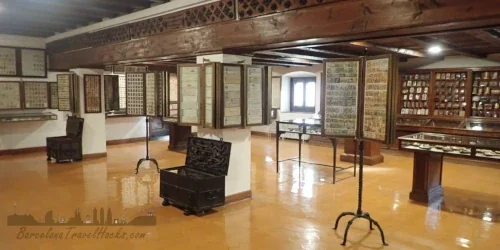Warning: Undefined array key "HTTP_ACCEPT_LANGUAGE" in /home/barcjkkl/public_html/App/Config/MySQL/language.php on line 32
Deprecated: explode(): Passing null to parameter #2 ($string) of type string is deprecated in /home/barcjkkl/public_html/App/Config/MySQL/language.php on line 36
Barcelona Dioceses Museum in the 4th Century Roman wall
Museum built into the roman wall that contains a collection of over 3000 sculptures, paintings, silverware and goldware, ceramics and religious clothing
About Barcelona Dioceses Museum in the 4th Century Roman wall
The need for the creation of the chair of Archaeology in the dioceses was established after the first congress of Christian art with the aim of preserving the artistic heritage of the church.
The Barcelona Dioceses Museum was founded December 15th 1915 and on 20th March 1916 the ground floor of the chaplains seminary in the Eixample district was used to display an exhibition that grew to house 600 items that were not in current use by the churches. The director first director of the museum was Minister Manuel Trens Ribes.
In 1929 the museum moved to its current location in Casa de la Pia Almoina.
During 1936 to 1939 during the Spanish Civil war, the museum was looted and set on fire like many of the churches leading to losses of some pieces of art.
In 1952 an exhibition of the museum works was held to raise awareness for the need to refurbish Casa de la Pia Almoina. The exhibition was held in Sala Tinel which is now part of the Barcelona History Museum.
In 1960 the Museum reopened provisionally in the Casa de la Pia Almoina location and was presided over by Bishop Gregorio Modrego Casaus. In 1976 the Museum closed.
From 1980 to 1985 the Museum was moved to the Palacio Episcopal for cataloging and preserving of the collection under the direction of Minister Josep M. Marti Bonet.
In 1985 an exhibition of the works of the museum was held bringing together over 170 pieces spanning from 1000 to 1800 AD.
In 1989 the Museum returned to the Casa de la Pia Almoina location and was very popular with the public. This also coincided with Barcelona cathedral opening its doors for tourists.
The museum continues to this day at the Casa de la Pia Almoina location hosting temporary shows on a variety of themes highlighting the relationship between faith and culture.
The museum has a collection along the lines of what can be found in the Museo Episcopal De Vic.
Image Gallery for Image Gallery For Barcelona Dioceses Museum in the 4th Century Roman wall
Click on any of the 55 images to open full screen gallery player
Visiting Barcelona Dioceses Museum in the 4th Century Roman wall
This museum should be considered as a companion to the cathedral visit. Combined Museum and cathedral tickets or museum only tickets are offered.
Note the doors at the exit and gift shop by sculptor Josep Plandiura, who created the Gaudiesque door on the front of the building in 1999
The attic space of the museum gives excellent views down onto Plaça de la Seu and the Cathedral façade.
- Every day except Tuesday: 10:00h to 20:00h
- Tuesdays: 11:00h to 20:00h
- Closed: January 1st and December 25th
Barcelona Dioceses Museum opening hours
What to take with you for What to take with you for Barcelona Dioceses Museum in the 4th Century Roman wall
The Barcelona Dioceses Museum is fully accessible for people with reduced mobility or pushchairs via the gift shop exit door in plaza Nova with a lift between all floors.
There is bicycle anchorage Plaza de la Seu here 41.384662, 2.176070 although this is not a location I would consider it safe to leave a bicycle chained up unattended.
When I visited I was allowed inside with my small 10L museum rucksack.
Don't forget headphones for the audio guide app.
Barcelona Dioceses Museum in the 4th Century Roman wall Summary of Prices Summary of Prices
Getting to Barcelona Dioceses Museum in the 4th Century Roman wall
Address: Plaza de la Seu S/N, Barcelona, 8002
The Barcelona Dioceses Museum is located in the middle of the gothic quarter approximately equidistant from Plaza Catalunya on the green (L3) line or Jaume I on the yellow (L4) line of the metro network. Use a T-Casual or Hola-Barcelona travel card.
Map for Barcelona Dioceses Museum in the 4th Century Roman wall
Weather for Barcelona Dioceses Museum in the 4th Century Roman wall
Where to stay overnight near Barcelona Dioceses Museum in the 4th Century Roman wall
8 Nearby Attractions to Barcelona Dioceses Museum in the 4th Century Roman wall
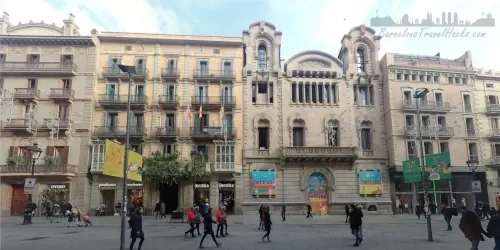
Portal de l'Angel - Barcelona Shopping in historic street
Former monastic land evolved into Barcelona's centrally located, designer brands, shopping street with late opening hours
Read more >
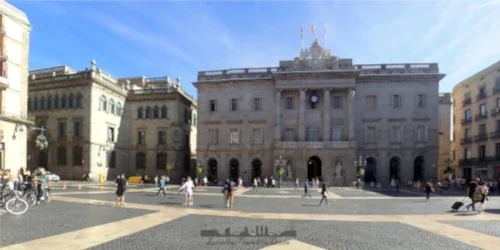
Barcelona Town Hall & Plaça Sant Jaume
Plaça Sant Jaume governmental buildings, Pont del Bisbe, Barcelona city hall Saló de Cent & Saló Carles Pi i Sunyer. Guided tourist visits
Read more >
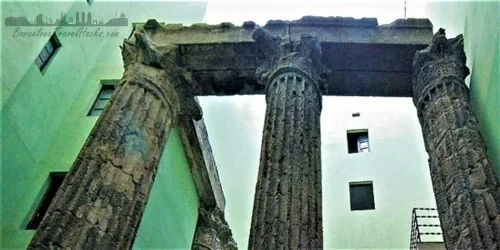
MUHBA Temple of Augustus - hidden Roman ruin in Barcelona
Remains of 2000 year old Roman Temple of Augustus. four columns Preserved within the interior courtyard of a medieval gothic building and FREE to visit
Read more >
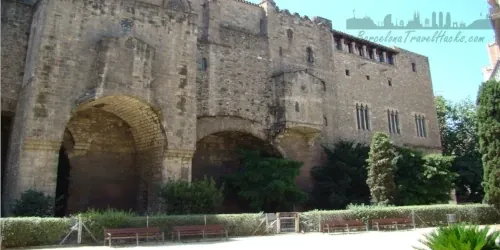
Roman Wall Remains & Plaça Ramon Berenguer III
The remains of the Roman wall run through Plaça Ramon Berenguer III (horse statue) and along Carrer de la Tapineria to Plaza Dels Traginers
Read more >
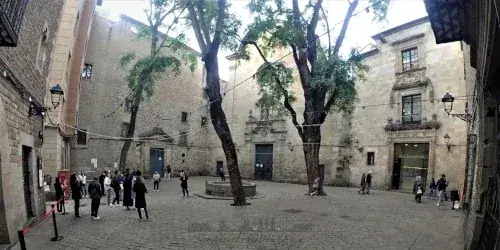
Plaça Sant Felip Neri with baroque church & fountain
Quaint secluded Gothic public square with baroque church showing bomb scars from the civil war, fountain and historic guild houses
Read more >
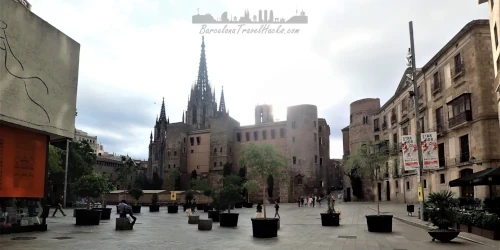
Barcelona's 14th Century Gothic Cathedral
Catedral de la Santa Creu i Santa Eulàlia in the Gothic Quarter. Visitor info, tickets & images from the cloister, cathedral & roof terrace
Read more >
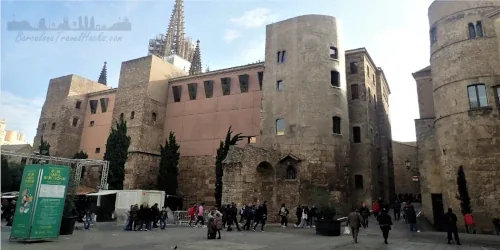
Casa de la Ardiaca - Archdeacons house - city archives
Beautiful interior courtyard, exhibition space & roof terrace. Building also houses the Barcelona historical archives and is built into the Roman city walls
Read more >
